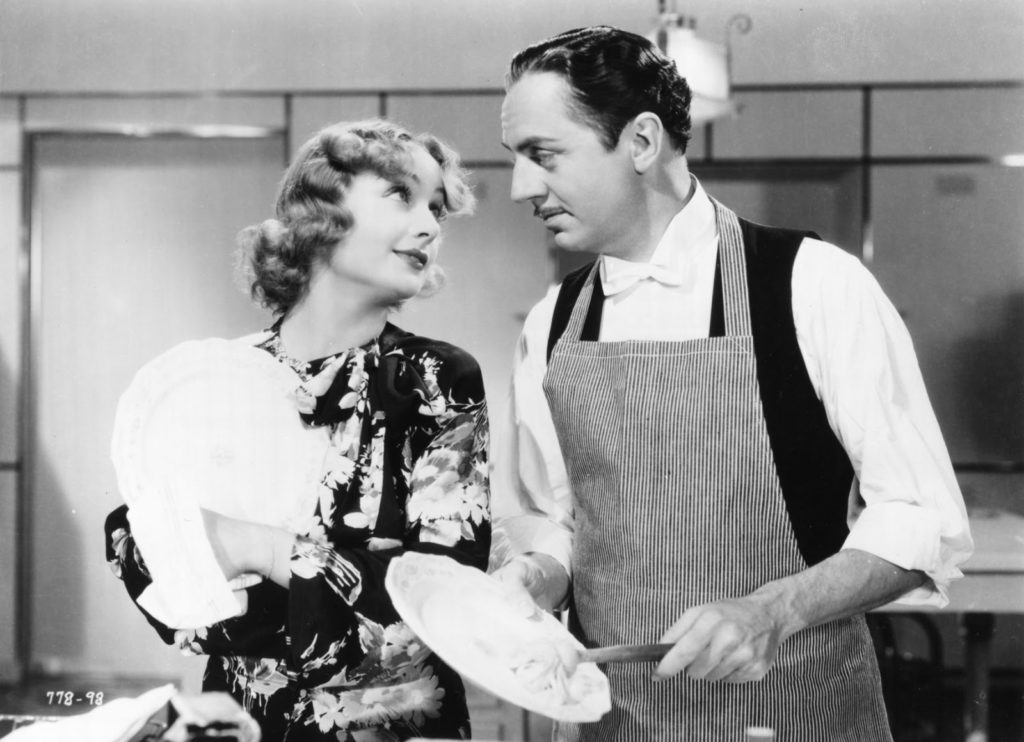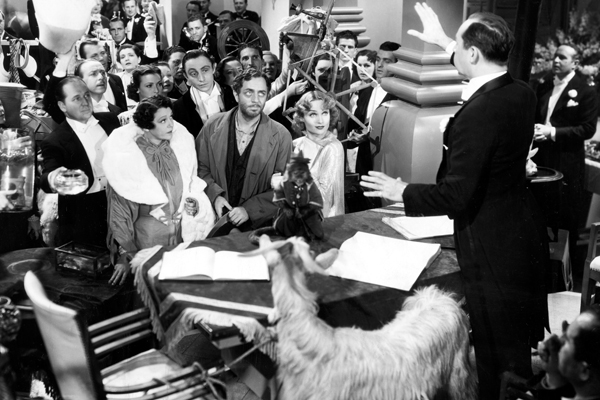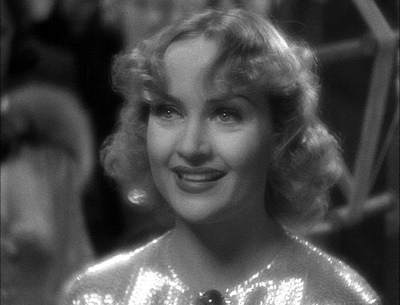This essay was originally published on ArtsandCrit.com (now sadly defunct) and has been dusted off and spruced up for its Retro Movie Buff debut.
In 1936, the Great Depression was in its fifth year, the average movie ticket cost $0.25 and a film review in trade magazine Variety made history by christening a new genre:
Lombard has played screwball dames before, but none so screwy as this one. Her whole family, with the exception of the old man, seem to have been dropped on their respective heads when young.
The Lombard in question was Carole and the film was My Man Godfrey, which, thanks to Variety, became the first ever movie to be referred to in print as a “screwball comedy.” (The term “screwball” comes from baseball and refers to a ball thrown fast and with a twist, to confuse the batter.)The tale of a ditzy heiress who falls for her family’s impeccable butler, My Man Godfrey was a hit with both critics and audiences alike and rapidly emerged as one of the signature films of Hollywood’s most topsy-turvy genre.
Off-kilter and frequently absurd, screwball comedy combined the slapstick style of early silent cinema with the sophisticated “drawing room” staccato patter of Broadway plays. It also responded to a specific moment in American history: the Great Depression. The gleeful excesses of the Roaring Twenties came to a crashing halt in 1929—along with the stock market—and thousands of Americans found themselves out of work. Although film attendance did not decline in 1929, by 1932 box office takings were down and several studios were struggling. Hollywood rebounded with a string of films that both confronted the problems of the Depression and showed characters triumphing over them: Warner Bros.’ gritty yet glamorous backstage musicals, including Gold Diggers of 1933—and its famous “Forgotten Man” number—were especially popular. In screwball comedies, the chaos onscreen not only reflected the massive upheavals in American society, but also gave audiences the chance to laugh at them too. Filmgoers could escape into a crazy world of headstrong heiresses and hapless authority figures, safe in the knowledge that order would eventually be restored. And if everything ended well onscreen, perhaps some semblance of order might resurface in the real world as well.
Much of the chaos in My Man Godfrey comes from the collision of two disparate worlds: that of the very rich and the very poor. Scatter-brained socialite Irene Bullock (Carole Lombard) is on a scavenger hunt, looking for a “forgotten man”, when she meets Godfrey (William Powell), an erudite bum, at the city dump, and hires him as the family’s new butler. The joke is, of course, that Godfrey proves to be far more cultured and grounded than his deranged employers. (Watching his wife (Alice Brady), swathed in furs, stride across the lobby of the Waldorf-Ritz Hotel with a goat in tow for the scavenger hunt, Irene’s father, Alexander Bullock (Eugene Pallette) isn’t the least surprised. “All you need to start an asylum is an empty room and the right kind of people,” he growls.) Audiences were not only delighted by the lunacy of the Bullock family, but also that they needed Godfrey’s guidance to survive—poverty-stricken viewers were reassured that the rich might benefit from the dignity of the poor.
The film was an immediate commercial and critical success. New York Times film critic Frank S. Nugent thought it “exuberantly funny”:
There may be a sober moment or two in the picture; there may be a few lines of script that do not pack a laugh. Somehow we cannot remember them.
It received six Academy Award nominations, including Best Director (Gregory La Cava) and Best Screenplay (Morrie Ryskind and Eric Hatch) and was the first film to receive nominations in all four acting categories, doing so in the year that the supporting categories were introduced. Surprisingly, it didn’t win a single award. Perhaps this was because the competition was so fierce: Powell was nominated alongside Walter Huston in Dodsworth, Gary Cooper in Mr. Deeds Goes to Town and Spencer Tracy in San Francisco. Inexplicably, the Best Actor Oscar actually went to Paul Muni for his excessively mannered performance in The Story of Louis Pasteur.
More than any other member of the cast or crew, My Man Godfrey was Lombard’s movie. Although she had piqued the public’s interest in Twentieth Century—the madcap Howard Hawks movie that is credited, along with It Happened One Night, with starting off the genre—it was My Man Godfrey that cemented Lombard as queen of screwball comedy. There were pretenders to the throne—Irene Dunne, Claudette Colbert and Jean Arthur—but none came to be as firmly identified with screwball as Lombard. In his book Romantic Comedy in Hollywood, from Lubitsch to Sturges, film critic James Harvey explains why:
Lombard was one reason the public indulged and tolerated some of the wilder excesses of that comedy: she was so lovely, so sexy, so widely beloved. She was like an ambassador to the sane prosaic world; she mediated the craziness even while she exacerbated it.
As Irene, Lombard perfected her own version of what Harvey calls the “Dizzy Little Woman,” a breezy, eccentric character type popular in thirties’ comic strips and radio shows (think Gracie Allen of Burns and Allen fame). Her performance launched a thousand lesser imitations (for example, Constance Bennett’s giddy socialite in Merrily We Live) and a screwball portfolio that would also include other classics like Nothing Sacred and To Be or Not To Be.
However, despite widespread acclaim for Lombard and for My Man Godfrey as a whole, the film’s reputation has fluctuated over the decades, largely due to one of its original selling points: its treatment of the Depression. In her book, Romantic Comedy, Tamar Jefffers Macdonald scolds the film for softening its social critique by revealing most of Godfrey’s neighbors at the dump to be not really bums at all:
Humans left on the ash-heap of life seem less pitiable, and society as a whole less guilty of abandoning them, if they have all chosen…to be there.
Yet their masquerade and Godfrey’s cure-all solution to their problems was enough to satisfy filmgoers still in the midst of the New Deal and its attempts to end mass unemployment.
Indeed, although its blend of crazy characters and social commentary is sometimes uneven, My Man Godfrey gave contemporary audiences what they most wanted in a screwball comedy: a shimmering art deco fantasy in black and white.



I am 66 years old (born 1953) and I LOVE this movie! I’ve watched it 3 or 4 times so far and seem to enjoy it more with each viewing – the anticipation of what’s coming improves the viewing IMHO. I watched it twice this month (Jan 2020), the first time was a colorized version (didn’t really like that) and then the B&W version.
This movie is still very relevant in 2020. William Powell’s ‘Godfrey’ is the friend we all wish we had – with his eye firmly set on the Big Picture, no obstacle too big to climb over. Never a discouraging word. The two sisters, Irene and Cornelia are as different on the outside as blond and brunette – but in reality they both love Godfrey for his stalwartness and faithfulness. Mr. Bullock is played so perfectly by Mr. Pallette, he is also a very lovable character as he tries to maintain his sanity while trying to guide and love his crazy family.
A lot of what make this movie still work is that it very cleverly illustrates the basic difference between men and women and their approach to the inanities of modern living. Us men could be more successful by being more like Godfrey, and less like Carlo (who leaves the movie via the side window!).
Hello Ace! I love this film too. You’re right about the Bullocks and Godfrey. He gets a second chance at life and seizes it, no matter what’s thrown in his way. That’s a very inspiring way to look at things, especially in a year like 2020.